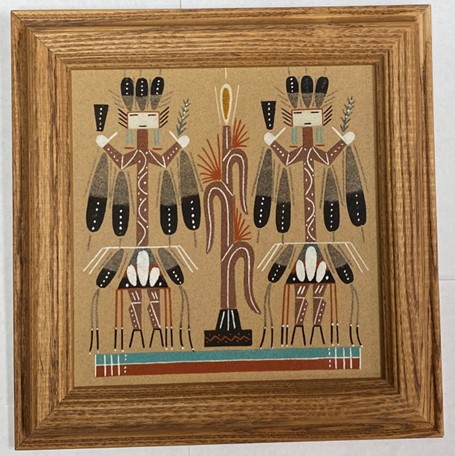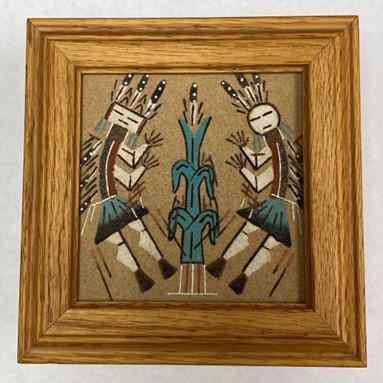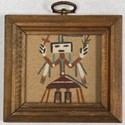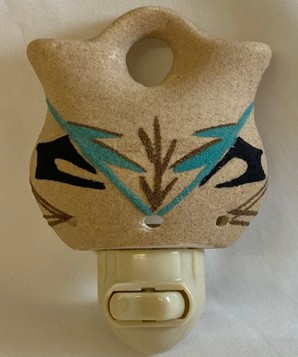The artworks in this exhibit are not actual Navajo sandpaintings, but reproductions. This is because traditional sandpaintings are made by arranging substances on the ground or on the floor, without any kind of binder or glue. These are therefore not permanent, but ephemeral artworks that may not be saved or collected.
Traditional sandpaintings are made by the Navajo (also known as the Dine) with loose, colored sand and natural pigments. The designs are carefully laid out with thin, precise lines on the ground or floor where the sandpainting ceremony takes place, and they serve as part of Navajo healing rituals. Traditional sandpaintings are made only by Singers, the traditional healers of the Navajo, and they are usually destroyed after the ceremony is over. This is both because the purpose of the sandpainting has been achieved in the ritual, and because the Navajo believe that the intact sandpainting may hold the sources of evil that were cast out of the ill person, and the paintings must therefore be obliterated; not destroying the sandpainting is running the risk of threatening the healing power of the spirits and rituals.
Because traditional sandpainting is a ritual artform, the making of sandpaintings for the tourist trade requires artists to learn the traditional imagery of ritual sandpaintings as well as how they may make sandpaintings as art that is considered appropriate to sell. While sandpaintings made as art incorporate traditional characters and motifs, and they resemble actual sandpaintings, they are not made by Singers for ritual use, they do not use ritually sacred materials, and they use different colors and details than in the ritual sandpaintings. Commercial sandpaintings are also glued or otherwise affixed to the wood, paper, canvas, or ceramic surface that the artist uses, so that they are permanent and durable as art. Some commercial sandpaintings also use simplified, standardized motifs and may be made with the use of stencils, so that they can be mass-produced quickly on different types of small objects to serve as inexpensive souvenirs.
The most important characters in Navajo sandpaintings are known as the Yei or the Yei Bei Chai, also known as the Rainbow People or the Holy People. In Navajo mythology, the Yei Bei Chai were once people who survived dangerous, catastrophic events, making them heroes; the Yei Bei Chai serve as benevolent guardian beings that help convert evil to good during a healing ceremony. In sandpaintings, Yei Bei Chai figures have elongated, colorful bodies; their heads and hands are often white, they wear short skirts, and often feathers hang from their bodies. Male Yei Bei Chai tend to have rounded heads, while female Yei Bei Chai tend to have rectangular heads.

by Jasper Begay
Navajo/Dine culture
20th century
Sand, wood, glue, and pigments, L. 27 cm x W. 2 mm x H. 27 cm
BFPC collection #2019.14
In this relatively large, framed sandpainting, the rectangular heads and the garments of the two Yei Bei Chai figures indicate that this image illustrates two particularly elaborate female characters. The two figures are depicted predominantly in the neutral colors of black, white, greyish brown, and grey. Each also wears clothing or body paint with intricately detailed designs, along with large, tasseled feathers in their headdresses and hanging from their arms and waists. Their raised arms and the position of their legs, facing inward, suggest that they are dancing on each side of the maize stalk in the center of the image. Researched by Lindsey Vandieren

Navajo/Dine culture
20th century
Sand, wood, glue, and pigments, L. 14 cm x W. 14 mm x H. 6.5 cm
BFPC collection #2008.21
This commercial sandpainting has been attached to a frame that serves as the lid of a small wooden box. The figures depicted in the painting are known as Yei Bei Chai, also known as Rainbow People or Holy People. While they are dressed in similar fashion, the figure on the left is identifiable as female, as it has a rectangular head, while the figure on the right is identifiable as male, as it has a round head. The two figures are curved and appear to be dancing around a bright bluish-green stalk of maize that grows in the center of the image. Researched by Lindsey Vandieren

by E. L. Yazzie
Navajo/Dine culture
20th century
Sand, wood, glue, and pigments, L. 11 cm x W. 2 mm x H. 11 cm
BFPC collection #2008.20
This small, framed sandpainting was made to sell as a souvenir of the American Southwest, but its unusual details suggests that it is not a mass-produced object that was made using only a stencil. The rectangular head of the Yei Bei Chai figure indicates that it is female, and it is shown wearing a large version of the traditional triangular skirt; however, the figure also has unusually large, white hands with delineated fingers, and it holds both a plant and brown cross. Researched by Lindsey Vandieren

Navajo/Dine culture
20th century
Sand, wood, glue, and pigments, L. 5 cm x W. 6 mm x H. 7.5 cm
BFPC collection #2020.27
This sandpainting is a good example of a mass-produced image that was quickly made using stencils. Because of its square head, the figure is identifiable as a female Yei Bei Chai figure. However, the figure is unusual in being very simplified, depicted without hands, and in wearing what appear to be pants. Researched by Lindsey Vandieren

by E.L. Yazzie
Navajo/Dine culture
20th century
Ceramic, plastic, metal, sand pigments, and glue,
L. 7 cm x W. 6 mm x H. 13.5 cm
BFPC collection #2017.11
This decorative night light is an example of mass-produced object with a sandpainting image that is made using stencils. The night light takes the form of a wedding vase, which is a vessel used in conjunction with American Southwest marriage ceremonies. The sandpainted designs on the surface are not traditional ceramic designs or traditional Navajo sandpainting motifs, but an image of plant-like and abstracted shapes that use a blue, brown, tan, and black color scheme and a sandy texture to evoke a general feeling of the American Southwest. Researched by Lindsey Vandieren
For more information, you may contact the researcher(s) noted in the title of this exhibit entry, or Dr. Billie Follensbee, the professor of the course, at BillieFollensbee@MissouriState.edu
